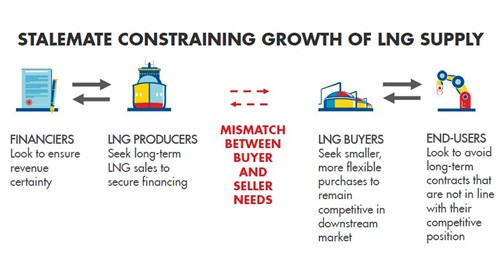LNG market needs $200B investment to meet demand - Shell
LONDON, (Reuters) - More than $200 billion of investment in liquefied natural gas is needed to meet a boom in demand by 2030, Royal Dutch Shell, the world's top LNG trader said.
The LNG market is set to continue its rapid expansion into 2020 as facilities approved for construction in the first half of the decade come online, in a development expected easily to meet sharp growth in consumption of the super-chilled fuel.
 |
| Shell forecasts possible LNG supply shortage as global demand grows (Photo: Shell LNG Outlook 2018) |
But a decline in spending in the sector since 2014 as a result of weaker energy prices will create a supply gap from the mid-2020s unless new investments emerge, Shell said in its 2018 LNG Outlook.
LNG plants are complex and expensive, requiring large processing units, known as trains, that cool natural gas to around minus 160 degrees Celsius (minus 260 Fahrenheit). The liquefied fuel is then shipped to demand centres and converted back into gas.
While LNG demand is expected to grow from 293 MMtpy in 2017 to around 500 MMtpy by 2030, supplies are seen slipping to 300 MMtpy due to a lack of new projects and natural declines in existing production, Shell's head of integrated gas and new energies, Maarten Wetselaar, said.
The cost of developing the required capacity is roughly $1 billion tonnes per year, Wetselaar said. That does not include investments in the development of the gas fields associated with LNG plants, he told reporters.
"The industry is still looking at quite a challenge to build supplies to meet demand in the 2020s," he said.
Shell is considering moving ahead on new projects such as LNG Canada and Lake Charles on the U.S. Gulf Coast, Wetselaar said. The Anglo-Dutch company is expected this year to launch the Prelude floating LNG plant in Western Australia, one of the largest and most complex gas projects in history.
"Our investment cycle is coming to an end with Prelude coming on stream this year. We will have the space to take investment decisions, (but) it doesn't necessarily mean we will spend the money."
Competition is fierce as projects have to face off against the lowest-cost gas hubs such as North America, where the shale boom has led to abundant and cheap supplies, as well as Qatar, Russia and East Africa.
"In order to take a final investment decision on a project of this size you want to make sure it is as low-cost as it can be because the cost of an LNG project ... is going to stick with you for 30, 40 years," Wetselaar said.
In its annual report - a legacy from BG Group, which the company acquired in 2016 - Shell forecast global demand for gas to grow by an average 2 percent per year until 2035. That would make gas the fastest-growing source of energy over the period.
LNG demand is set to grow twice as fast as gas power plants in China, South Korea and India switch from coal and governments move to reduce carbon emissions, Shell said.
(Reporting by Ron Bousso; Editing by Dale Hudson)

- ExxonMobil halts 1-Bft3d blue hydrogen project in Texas
- Aramco and Yokogawa commission multiple autonomous control AI agents at Fadhili gas plant
- Ukraine will resume gas imports via Transbalkan route in November
- Mitsubishi to inject $260 MM into Brunei LNG project
- Freeport LNG (U.S.) on track to take in more natgas on Thursday after unit outage



Comments